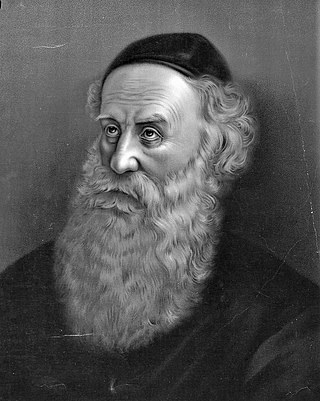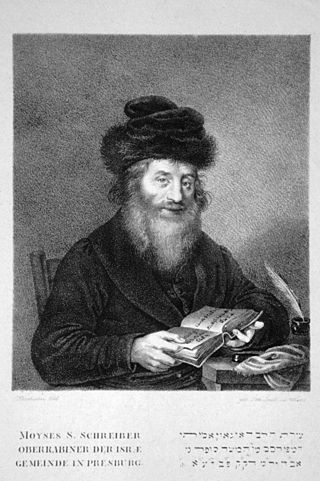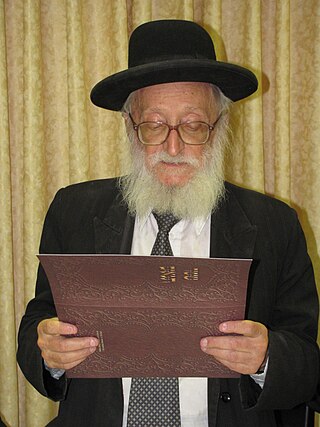Related Research Articles

A siddur is a Jewish prayer book containing a set order of daily prayers. The word siddur comes from the Hebrew root ס־ד־ר, meaning 'order.'

Yitzchak Hutner, also known as Isaac Hutner, was an American Orthodox rabbi and rosh yeshiva (dean).

Shneur Zalman of Liadi was a rabbi and the founder and first Rebbe of Chabad, a branch of Hasidic Judaism. He wrote many works, and is best known for Shulchan Aruch HaRav, Tanya, and his Siddur Torah Or compiled according to the Nusach Ari.

Vizhnitz is the name of a Hasidic dynasty founded by Rabbi Menachem Mendel Hager. Vizhnitz is the Yiddish name of Vyzhnytsia, a town in present-day Ukraine.

Moses Schreiber (1762–1839), known to his own community and Jewish posterity in the Hebrew translation as Moshe Sofer, also known by his main work Chatam Sofer, Chasam Sofer, or Hatam Sofer, was one of the leading Orthodox rabbis of European Jewry in the first half of the nineteenth century.

Nadvorna is a Hasidic rabbinical dynasty deriving its name from the town of Nadvorna, (Nadvirna), today in Ukraine.

Elazar Menachem Man Shach was a Haredi rabbi who headed Misnagdim Orthodox Jews in Israel and around the world from the early 1970s until his death. He served as chair of the Council of Sages and one of three co-deans of the Ponevezh Yeshiva in Bnei Brak, along with Shmuel Rozovsky and Dovid Povarsky. Due to his differences with the Hasidic leadership of the Agudat Yisrael political party, he allied with Ovadia Yosef, with whom he founded the Shas party in 1984. Later, in 1988, Shach criticized Ovadia Yosef, saying that, "Sepharadim are not yet ready for leadership positions", and subsequently founded the Degel HaTorah political party representing the Litvaks in the Israeli Knesset.
Dushinsky is one of the few Hasidic dynasties not named after the place where it originated; instead, it is named after the rebbe's surname. It is relatively new, and became a dynasty in Jerusalem, where it is centered today. Unlike other Hasidic groups, it does not originate from a Hasidic background, but from the talmidim (students) of Moses Sofer.

Soltvadkert is a town in Bács-Kiskun County in Hungary with approximately 8,000 inhabitants. The former name of the town is Vadkert. It is surrounded by several areas of Kiskunság National Park and Lake Vadkert.

Moetzes Gedolei HaTorah is the supreme rabbinical policy-making council of the Agudat Yisrael and Degel HaTorah movements in Israel; and of Agudath Israel of America in the United States. Members are usually prestigious Roshei Yeshiva or Hasidic rebbes, who are also usually regarded by many Haredi Jews to be the Gedolim ("great/est") sages of Torah Judaism. Before the Holocaust, it was the supreme authority for the World Agudath Israel in Europe.
For the purposes of this article, “contemporary” refers to the period from 1967 to the present day, “Jewish” refers to the various streams and traits of Judaism practiced. Many Orthodox Jews use the term “religious” to refer to a strict adherence to Jewish law. For the purposes of this article, “religious” refers to the content and context of the music itself: liturgical or implicit references to the divine.

The Central Rabbinical Congress is a rabbinical organization that is a consortium of various Haredi Jewish groups, with offices in Brooklyn, New York.

Khal Adas Yisroel, usually referred to as the Schiff Shul, was the main Orthodox synagogue in Vienna prior to the Holocaust. The synagogue no longer exists since it was destroyed by the Nazis on Kristallnacht. A building that was adjacent to the Schiffshul and was part of its complex remains.

Chona Menachem Mendel (Mendel) Weinbach was an Orthodox Jewish rabbi, educator, author, and speaker. As the co-founder and dean of Ohr Somayach Institutions, a Jerusalem-based yeshiva for newly-observant Jewish men, he was considered one of the fathers of the modern-day baal teshuva movement.
Erlau, is a Haredi dynasty of Hungarian origin, which follows the teachings of the Chasam Sofer and is often considered Hasidic.
In Jewish law, a posek is a legal scholar who determines the application of halakha, the Jewish religious laws derived from the written and Oral Torah in cases of Jewish law where previous authorities are inconclusive, or in those situations where no clear halakhic precedent exists.
Musar literature is didactic Jewish ethical literature which describes virtues and vices and the path towards character improvement. This literature gives the name to the Musar movement, in 19th century Lithuania, but this article considers such literature more broadly.
Vien (וויען) is a Rabbinical hasidic dynasty originating in present-day Vienna. The previous rav of Vien was Rav Chaim Z. Hersh Zegelbaum of Brooklyn, New York. He was a descendant of Rav Menachem Mendel Stern (1759–1834) of Sighet, author of Derech Emunah.
Melitz was a Galician Hassidic dynastic sect, a branch of the Ropshitz Hasidic sect. The progenitor of the dynasty was Rabbi Ya'akov Horowitz, the son of Rabbi Naftali Zvi Horowitz of Ropshitz.
References
- ↑ The Jewish Press
- ↑ Interview on April 25, 2009 in Brooklyn, NY with Eli Richter - son of Karl Richter